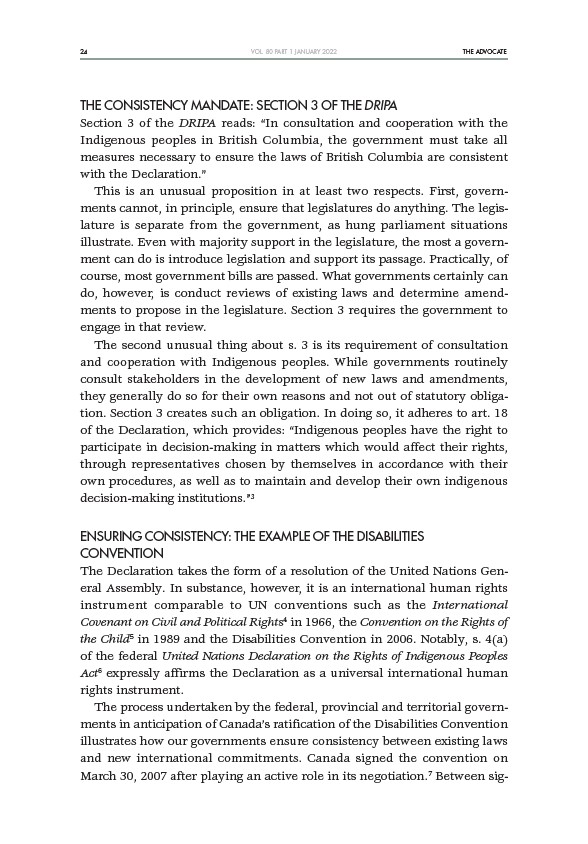
24 THE ADVOCATE
VOL. 80 PART 1 JANUARY 2022
THE CONSISTENCY MANDATE: SECTION 3 OF THE DRIPA
Section 3 of the DRIPA reads: “In consultation and cooperation with the
Indigenous peoples in British Columbia, the government must take all
measures necessary to ensure the laws of British Columbia are consistent
with the Declaration.”
This is an unusual proposition in at least two respects. First, governments
cannot, in principle, ensure that legislatures do anything. The legislature
is separate from the government, as hung parliament situations
illustrate. Even with majority support in the legislature, the most a government
can do is introduce legislation and support its passage. Practically, of
course, most government bills are passed. What governments certainly can
do, however, is conduct reviews of existing laws and determine amendments
to propose in the legislature. Section 3 requires the government to
engage in that review.
The second unusual thing about s. 3 is its requirement of consultation
and cooperation with Indigenous peoples. While governments routinely
consult stakeholders in the development of new laws and amendments,
they generally do so for their own reasons and not out of statutory obligation.
Section 3 creates such an obligation. In doing so, it adheres to art. 18
of the Declaration, which provides: “Indigenous peoples have the right to
participate in decision-making in matters which would affect their rights,
through representatives chosen by themselves in accordance with their
own procedures, as well as to maintain and develop their own indigenous
decision-making institutions.”3
ENSURING CONSISTENCY: THE EXAMPLE OF THE DISABILITIES
CONVENTION
The Declaration takes the form of a resolution of the United Nations General
Assembly. In substance, however, it is an international human rights
instrument comparable to UN conventions such as the International
Covenant on Civil and Political Rights4 in 1966, the Convention on the Rights of
the Child5 in 1989 and the Disabilities Convention in 2006. Notably, s. 4(a)
of the federal United Nations Declaration on the Rights of Indigenous Peoples
Act6 expressly affirms the Declaration as a universal international human
rights instrument.
The process undertaken by the federal, provincial and territorial governments
in anticipation of Canada’s ratification of the Disabilities Convention
illustrates how our governments ensure consistency between existing laws
and new international commitments. Canada signed the convention on
March 30, 2007 after playing an active role in its negotiation.7 Between sig-